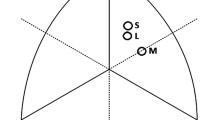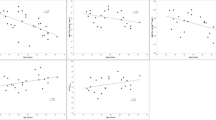Summary
Six male and six female runners were chosen on the basis of age (20–30 years) and their performance over the marathon distance (mean time = 199.4, SEM 2.3 min for men and 201.8, SEM 1.8 min for women). The purpose was to find possible sex differences in maximal aerobic power (VO2max), anaerobic threshold, running economy, degree and utilization of VO2max (when running a marathon) and amount of training. The results showed that performance-matched male and female marathon runners had approximately the same VO2max (about 60 ml·kg−1·min−1). For both sexes the anaerobic threshold was reached at an exercise intensity of about 83% of VO2max, or 88%–90% of maximal heart rate. The females' running economy was poorer, i.e. their oxygen uptake during running at a standard submaximal speed was higher (P<0.05). The heart rate, respiratory exchange ratio and blood lactate concentration also confirmed that a given running speed resulted in higher physiological. strain for the females. The percentage utilization of VO2max at the average marathon running speed was somewhat higher for the females, but the difference was not significant. For both sexes the oxygen uptake at average speed was 93%–94% of the oxygen uptake corresponding to the anaerobic threshold. Answers to a questionnaire showed that the females' training programme over the last 2 months prior to running the actual marathon comprised almost twice as many kilometres of running per week compared to the males (60 and 33 km, respectively). The better state of training of the females was also confirmed by a 10% higher VO2max, in relation to lean body mass than that of the male runners. Apart from the well-known variation in height and differences in the percentage of fat, the difference between performance-matched male and female marathon runners seemed primarily to be found in running economy and amount of training.
Similar content being viewed by others
References
Berg A, Keul J (1981) Physiological and metabolic responses of female athletes during laboratory and field exercise. Women and sport. Med Sport 14:77–96
Bransford DR, Howley ET (1977) Oxygen cost of running in trained and untrained men and women. Med Sci Sports Exerc 9:41–44
Conley DL, Krahenbuhl GS (1980) Running economy and distance running performance of highly trained athletes. Med Sci Sports Exerc 12:357–360
Costill DL (1970) Metabolic responses during distance running. J Appl Physiol 3:251–255
Costill DL, Fox EL (1969) Energetics of marathon running. Med Sci Sports Exerc 2:81–86
Costill DL, Thomason H, Roberts E (1973) Fractional utilization of the aerobic capacity during distance running. Med Sci Sports Exerc 5:248–252
Costill DL, Fink WJ, Getchell IH, Ivy JL, Witzmann FA (1979) Lipid metabolism in skeletal muscle of endurance-trained males and females. J Appl Physiol 4:787–791
Cureton KJ, Sparling PB (1980) Distance running performance and metabolic responses to running in men and women with excess weight experimentally equated. Med Sci Sports 4:288–294
Daniels J, Krahenbuhl C, Foster C, Gilbert J, Daniels S (1977) Aerobic responses of female distance runners to submaximal and maximal exercises. Ann NY Acad Sci 301:726–733
Davies CTM, Thomason MW (1979) Aerobic performance of female marathon and male ultra marathon athletes. Eur J Appl Physiol 41:233–245
Dillmann CJ (1975) Kinetic analyses of running. Exerc Sport Sci Rev 3:193–218
Drinkwater BL (1973) Physiological responses of women to exercise. Exerc Sport Sci Rev 1:125–153
Farrell PA, Wilmore JH, Coyle EF, Billing JE, Costill DL (1979) Plasma lactate accumulation and distance running performance. Med Sci Sports Exerc 11:338–344
Fischer RA (1954) Statistical methods for research workers. Liver and Loyd, Edinburgh
Heck VH, Mader H, Liesen H, Hollman W (1982) Vorschläge zur Standardisierung leistungsdiagnostischer Untersuchungen auf dem Laufband. Dtsch Z Sportmed 9:304–307
Hjemdahl P, Fredholm B (1974) Comparison of the lipolytic activity of circulating and locally released noradrenalin during acidosis. Acta Physiol Scand 92:1–11
Ingjer F (1979) Adaptions in human skeletal muscle induced by endurance training. Thesis, Norwegian University of Sport and Physical Education, and Anatomical Institute, University of Oslo, Oslo
Issekutz B, Shaw W, Issekutt I (1975) Effect of lactate on FFA and glycerol turnover in resting and exercising dogs. J Appl Physiol 39:349–353
Jansson E (1980) Diet and muscle metabolism in man. Acta Physiol Scand [Suppl] 487:1–24
Komi PV, Karlsson J (1979) Physical performance, skeletal muscle enzyme activities and fiber types in monozygous and dizygous twins of both sexes. Acta Physiol Scand [Suppl] 462:1–28
Maron MB, Horvath SM, Wilkerson JE, Gliner J (1976) Oxygen uptake measurements during competitive marathon running. J Appl Physiol 5:836–838
Nelson RC, Brooks CM, Pike NL (1977) Biomechanical comparison of male and female distance runners. Ann NY Acad Sci 301:793–807
Pate RR, Barnes C, Miller W (1985) A physiological comparison of performance-matched male and female distance runners. Res Q Exerc Sport 56:245–250
Sjødin B, Jacobs I (1981) Onset of blood lactate accumulation and marathon running performance. Int J Sports Med 2:23–26
Sloan AW (1967) Estimation of body fat in young men. J Appl Physiol 23:311–315
Sloan AW, Burt JJ, Blyth CS (1962) Estimation of body fat in young women. J Appl Physiol 17:967–970
Soutter WP, Sharp F, Clark DM (1978) Bedside estimation of whole blood lactate. Br J Anaesth 50:445–450
Stanley LJ, Brubaker CE (1973) Biomechanical and neuromuscular aspects of running. Exerc Sport Sci Rev 1:189–216
Wilmore J, Brown CH, Davies JH (1977) Body physique and composition of the female distance runner. Ann NY Acad Sci 301:764–776
Author information
Authors and Affiliations
Rights and permissions
About this article
Cite this article
Helgerud, J., Ingjer, F. & Strømme, S.B. Sex differences in performance-matched marathon runners. Europ. J. Appl. Physiol. 61, 433–439 (1990). https://doi.org/10.1007/BF00236064
Accepted:
Issue Date:
DOI: https://doi.org/10.1007/BF00236064




